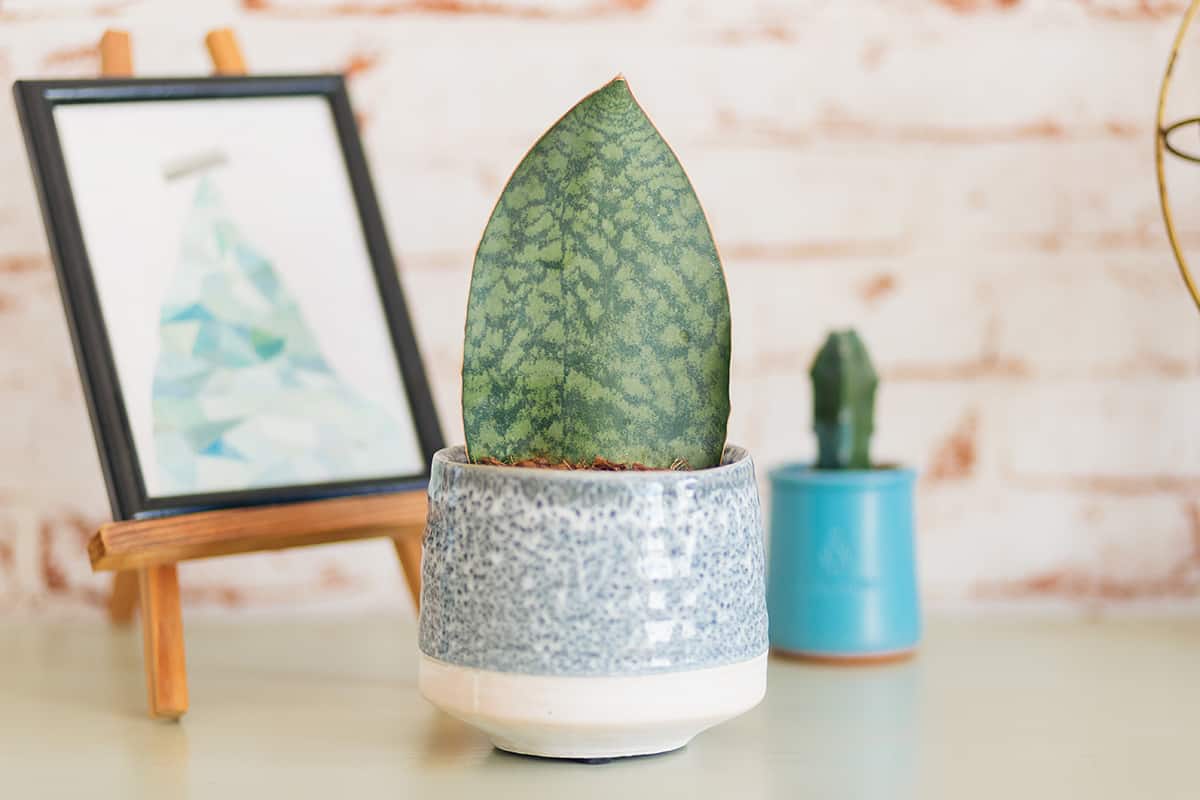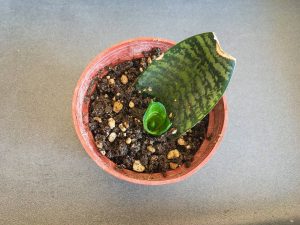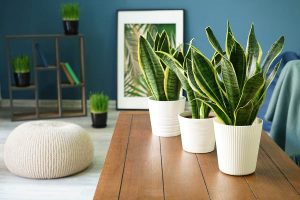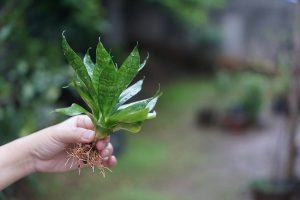The Whale Fin Snake Plant is a striking variety that is instantly recognizable from its huge single leaf that heavily resembles the fin of a whale. This plant hails from the Democratic Republic of the Congo in Africa, so it also goes by the common name of ‘Mason Congo Sansevieria’.
The unusual look of this snake plant has led to a surge in its popularity as a houseplant. Here you can learn all about how to take care of this gorgeous snake plant variety.
| Botanical name | Sansevieria Masoniana |
| Common names | Whale Fin Snake Plant, Shark Fin Snake Plant, Mason Congo Sansevieria |
| Plant family | Asparagaceae |
| USDA hardiness zone | 10 – 12 |
| Mature height | 3 to 4 feet |
| Mature spread | 1 to 2 feet |
Table of Contents
Varieties of Whale Fin Snake Plant
Snake plants are succulents that make great house plants because they are easy to grow and require little care or maintenance. Some snake plants have very distinguishing qualities which set them apart from other snake plants, while some are so similar it is easy to get confused. Here we look at a few other varieties of snake plants similar to the Whale Fin Snake Plant.
Sansevieria Grandis
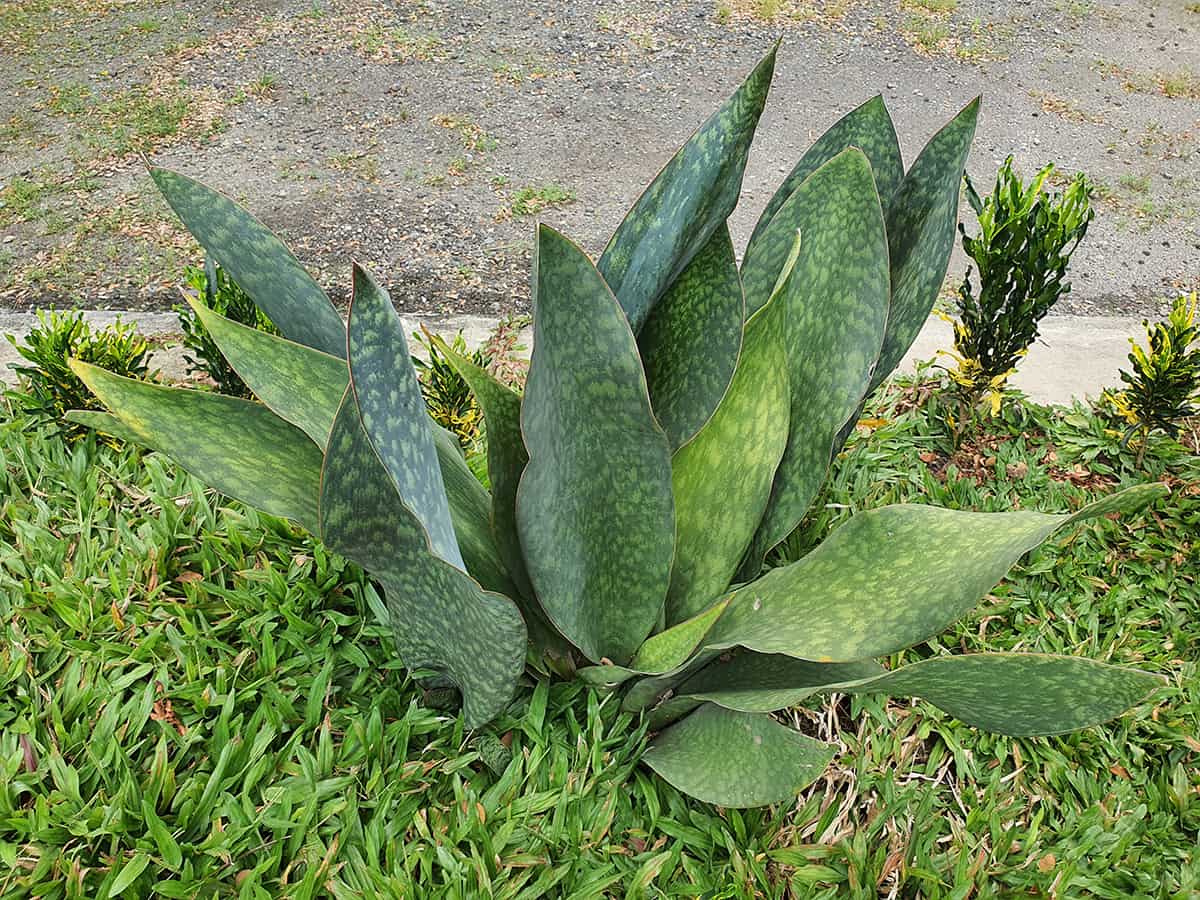
This is the variety of snake plants that most closely resembles the Whale Fin Snake Plant, and in fact, it is quite common for the two to get mistaken for each other. This plant is commonly known as the Somali Good Luck Plant, and like the Whale Fin Snake Plant, it produces oversized leaves in dark green mottled patterns.
The main difference between these two plants is that the Somali Good Luck Plant will not reach anywhere near the great size of the Whale Fin Snake Plant. If you are struggling to know if your plant is a true Whale Fin Snake Plant, the best way to identify it is by inspecting the rhizome at the base of the leaf where it enters the soil.
The rhizome is the chunky white part of the plant from which all of the roots sprout. On a Whale Fin Snake Plant, the rhizome will be white and purple in color, whereas the Somali Good Luck Plant will not have any hint of purple on the rhizome.
Sansevieria trifasciata Laurentii

This is the most readily available type of snake plant houseplant. It has dark green upright leaves with zigzag patterns and yellow margins. It produces clumps of foliage that grow tightly together to create a strong architectural look, in comparison to the Whale Fin Snake Plant, which is typically grown as a single leaf.
The color and patterns of the foliage on both of these plants are very similar, though the Whale Fin Snake Plant does not have yellow margins on its leaves.
How to Care for Your Whale Fin Snake Plant
The Whale Fin Snake Plant is a low-maintenance variety of snake plant, whether you grow it as a houseplant or outside in a warm climate. Here we share tips and advice to get the best out of your Whale Fin Snake plant.
Light
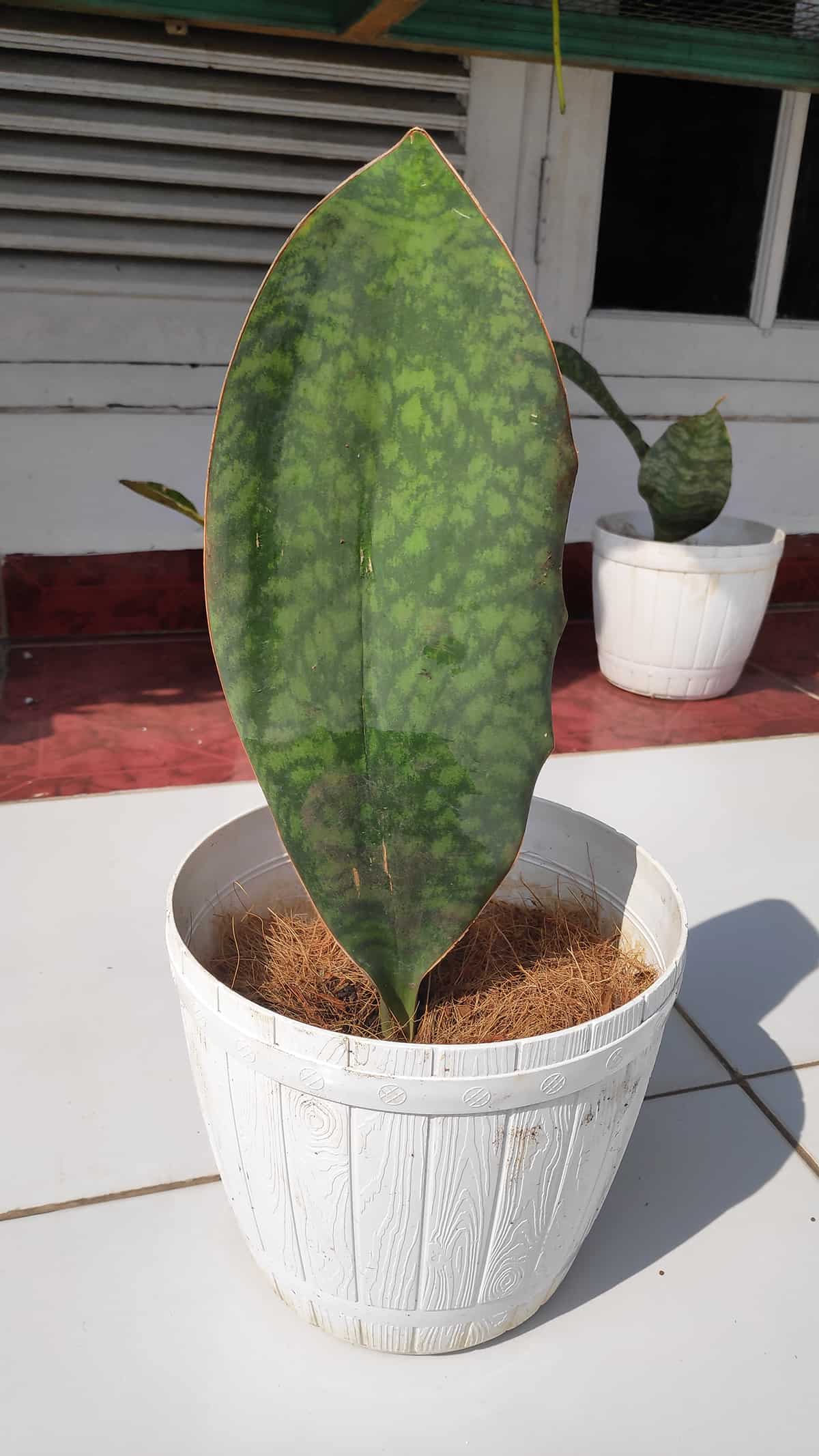
This plant is native to the Democratic Republic of the Congo in Africa, where it grows in open grasslands and on roadsides. As such, it is accustomed to getting a mixture of direct sunlight and shade. However, if you are growing the Whale Fin Snake Plant as a houseplant, it will be best to avoid direct light at first because if the plant is not used to this, it can cause the foliage to burn.
Instead, choose a spot where the plant can receive bright, indirect light, such as on a windowsill with blinds to create dappled light, or set back from a bright and sunny window. The Whale Fin Snake Plant can tolerate low levels of light, but this will slow the growth of the plant.
Snake plants, in general, are quite a slow-growing species, but the Whale Fin Snake Plant is one of the slowest of all snake plants when it comes to growth. If you grow your Whale Fin Snake Plant in a shaded position, you will find that it struggles to gain much height or width at all.
For the best growth, give it bright indirect light; however, you can gradually subject the plant to direct light if you wish. Do this by moving it into a full sun position for an hour or so each day, increasing the amount of time spent in the direct sun each week until the plant has learned to tolerate full sun without scorching.
Soil
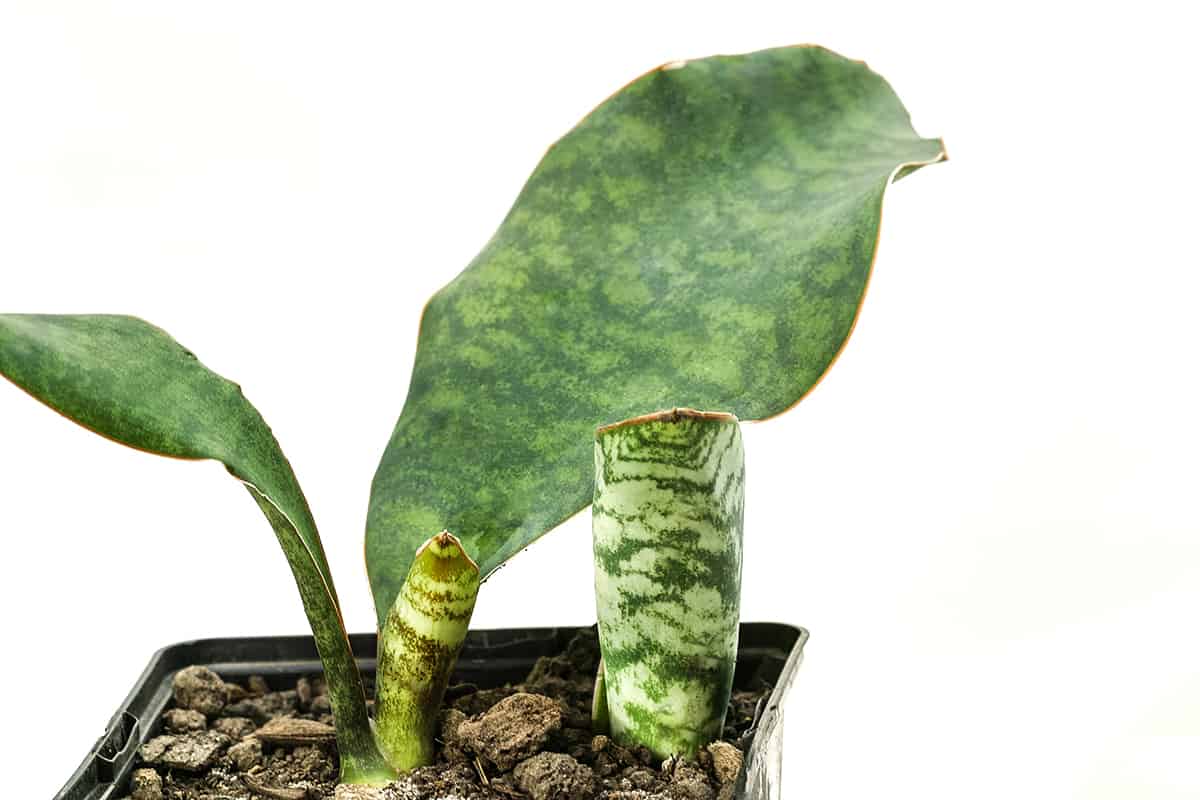
Whale Fin Snake Plants should be grown in well-draining soil to encourage water to drain away from their roots. Snake plants cannot tolerate wet environments, so ensuring you use high-quality well-draining soil will go a long way to ensuring that the roots of the plant are not subjected to a life spent in wet soil. A succulent potting mix will be ideal, or you can mix perlite into your regular potting mix to improve drainage.
Water
Whale Fin Snake Plants need very little water. Overwatering this plant is the most likely way to kill it, so err on the side of caution when it comes to supplying it with water. This plant would much prefer to be in dry soil and a short period of drought, as opposed to wet soil and too much moisture.
Excess water around the roots will cause the Whale Fin Snake Plant to suffer root rot, which typically signals the demise of a plant. To prevent this from happening, water with care. During the warmer months, the plant will need more water compared with cool months because this is when it receives longer daylight hours and is actively growing.
During this time, you can expect to water the Whale Fin Snake Plant around 2 to 3 times a month. In winter, cut this back to just once a month. Rather than sticking to a schedule, the best way to ensure correct watering is to check soil conditions. If the soil has dried out on the top few inches, you can go ahead and water.
If it still feels moist, don’t water it. When you water the plant, be generous with water to give the roots a good soak until water begins to seep out of the drainage holes.
Temperature
The Whale Fin Snake Plant enjoys warm temperatures which mimic those found in its native habitat. The typical temperatures found in homes are ideal, making this plant well-suited to life indoors. You can also grow the Whale Fin Snake Plant outside in USDA hardiness zones 10 to 12. This plant is very vulnerable to low temperatures and frost, so if you move it outside for summer, you must always return it inside when temperatures begin to drop.
Humidity
The Whale Fin Snake Plant is not very fussy at all when it comes to humidity and can tolerate low humidity, moderate humidity, and high humidity. If you enjoy low-maintenance plants, then the Whale Fin Snake Plant is ideal because you don’t need to remember to spritz it with water like many other tropical houseplants. This plant will be perfectly happy in the regular humidity level of your home, and you don’t need to take measures to try to raise humidity levels.
Fertilizer
This plant is not dependent on fertilizer, but there is no harm in feeding it if you like to fertilize your houseplants. Give diluted liquid fertilizer to the Whale Fin Snake Plant at one-month intervals throughout the growing period, and then stop completely from September through to May.
Can You Propagate Whale Fin Snake Plants?
Yes, this plant is great for propagating if you want to create new Whale Fin Snake Plants. Often snake plants can be propagated by division, and while this is possible with the Whale Fin Snake Plant, it is not the most obvious way to propagate since Whale Fin Snake Plants are ordinarily grown alone with one single leaf or from one rhizome.
Instead, taking leaf cuttings or removing cuttings is the typical way to propagate this plant. If your Whale Fin Snake Plant starts to send out pups, you can use a sharp knife to remove the pup from the mother plant at the rhizome and plant it directly into a small-sized pot of moist soil.
Within a few weeks, the pup will develop roots and can grow into a whole new Whale Fin Snake Plant. If your Whale Fin Snake Plant has more than one leaf, identify which is the main leaf (usually the largest leaf) and leave this intact. Close to the rhizome at soil level, remove the other leaf with a horizontal cut.
This is a leaf cutting. Set this in a cool, dry place for a few days to callous over, and then plant it into a small pot of well-draining soil. It will begin to send out roots of its own and develop into a fully-fledged separate plant.
